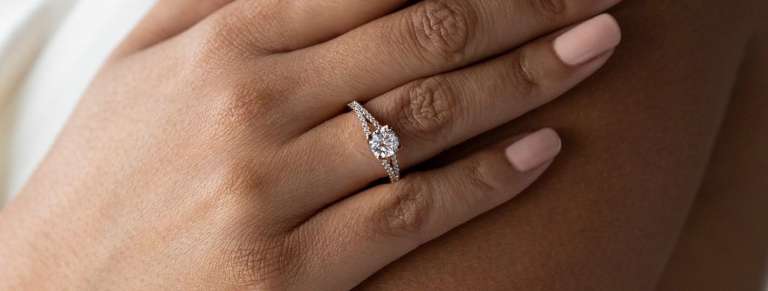Whether you’re looking for a way to tastefully accent your center stone or if you want enough diamonds lining your band to make people do a double-take, pavé engagement ring settings are perfect for people who simply cannot get enough sparkle.
Commonly used in engagement and wedding ring designs, people swoon for the pave’s irresistible dazzle and versatility. Stick around to discover just what exactly the term pavé means and how you can incorporate it into your forever adornment to create the ring and Pavé Setting Styles of your dreams.
What Does Pavé Setting Mean?
The French word for “pavement”, a Pave (pronounced pah-vey) setting features several tiny gemstones or diamonds that “pave” the metal. Extremely popular in wedding band and engagement ring designs alike, pavé settings bring a welcomed pop of sparkle as bright stones cover the band to optimize the ring’s overall brilliance and detail.
There are several pavé engagement ring designs to choose from. Whether you’re looking for just a hint of extra sparkle or want to go all out with diamonds there’s a pavé style for you.
What Are the Different Types of Pavé Settings?
Micro Pavé
Crafted using very small diamonds, typically smaller than .01 of a carat, micro pavé settings create the illusion that the entire band is made of diamonds. Rings in this style often feature multiple rows of glimmering gems that cover the entire band.
The average micro pavé setting can hold up to 50 diamonds, sometimes, even more, making rings of this style especially beautiful to those who adore the irresistible sparkle of a diamond. Of course, all of those small stones add up. For this reason, a micro pavé setting can be more costly than other engagement ring styles.
U-Cut Pavé
The u-cut is among the most popular type of settings when it comes to paves. Modern in design, u-cut settings feature a series of grooves into which smaller stones are set, creating a u-like shape when viewed from the side.
A great way to increase your diamond to metal ratio without completely hiding the natural beauty of your wedding band, u-cut designs can be paired with a sleek solitaire band or combined with fancy filigree for a vintage vibe.

French Pavé
Also referred to as the fishtail pave, the French pavé is famous for its one-of-a-kind textured appearance. In this style, pave-set diamonds are placed into v-shaped grooves that are cut into the band of the ring. While similar in concept to the u-cut, the French pavé actually enhances the sparkle of a gemstone even more as it allows more light to pass through.
Wedding rings in this style are beloved as they require a minimal amount of metal to hold the accent diamonds into place.
Petite Pavé
A member of the traditional pavé setting family, the petite pavé uses tiny prongs to keep each micro pavé diamond in place. And while you might not think that prong size would make much of a difference, the smaller the metal prongs are the more visible and prominent each diamond appears.
Bright Cut Pavé
Also referred to as channel set pavé due to the placement of round melee between two walls of metal, bright cut pavé is one of the oldest styles of pave. While aesthetically pleasing, the distinctive “bright cut” metal walls that frame the small stones aren’t just for looks, in fact, they play an important role in improving the overall durability of the piece.
People love the antique vibe of a channel setting and rings in this style are enjoying a resurgence as vintage engagement rings continue to grow in demand.

Scalloped Pavé
Featuring similar design elements as the u-shaped pave, scalloped pavé settings feature metal beads with u-shaped cutouts underneath to hold the accent diamonds into place. This variety of pavé is less commonly used in engagement ring designs and you’re more likely to see it featured in wedding bands or right hand rings.
What Is the Difference Between Pavé and Micro Pavé?
Easily confused, pavé and micro pavé are two different things. The term pavé refers to any size stone that is set in the band whereas micro pavé refers to several stones that are all the same size and are typically far smaller in carat weight than gemstones used in a pave.

Pros and Cons of Pavé Settings
Pros:
- Pavé settings add extra sparkle and shine to the center stone, drawing the eye to its beauty.
- The additional diamonds in a pavé setting create a more dramatic and eye-catching appearance.
- Pavé settings can be paired with a variety of center stones, from bold emerald cuts to romantic princess cuts.

Cons:
- Pavé settings can be more expensive than other engagement ring styles due to the labor-intensive process of setting each stone individually.
- Resizing a pavé setting can be challenging, so it’s essential to ensure the correct ring size from the start.
- The intricate design elements of a pavé setting provide more places for dirt to hide, requiring regular cleaning to maintain its sparkle.

Whether you’re considering a pave style for engagement rings vs wedding rings or looking for classic engagement rings, the options are plenty. With endless pave ring setting styles, you’re sure to find the perfect engagement ring setting for your special day. Visit us at Luxyverse online for more help with pave settings and different ring styles.






Leave a Comment